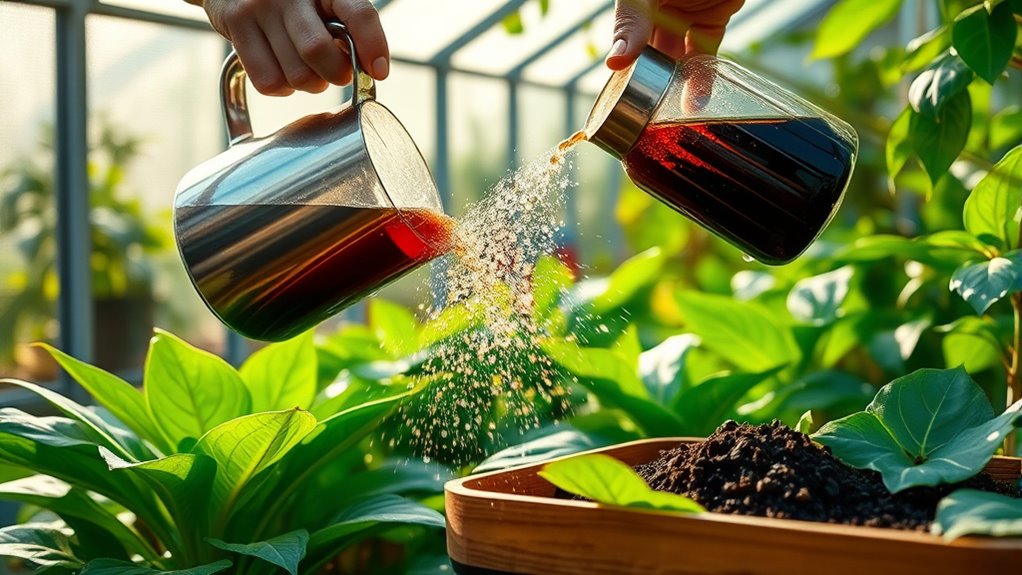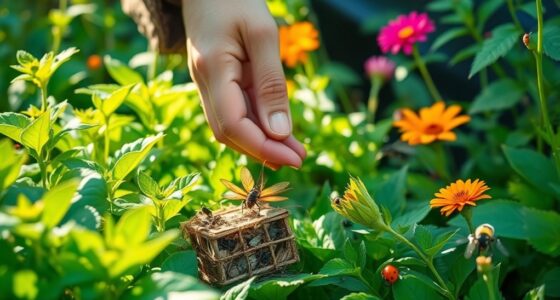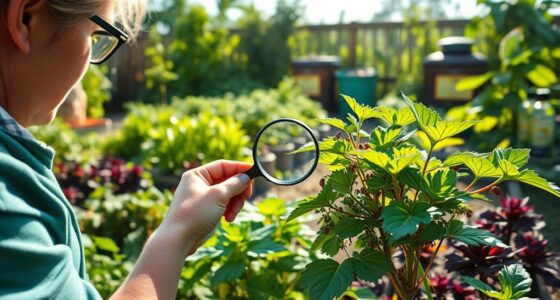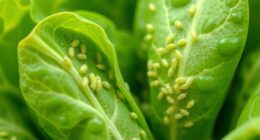To brew and apply compost tea for foliar disease suppression, start with high-quality, mature compost rich in beneficial microbes. Steep the compost in water with aeration for 24-48 hours, then strain it before spraying evenly on plant surfaces, covering both sides of leaves. Add beneficial amendments like seaweed or molasses for extra microbial diversity. Apply during early morning or late afternoon, repeating every 7-14 days for best results. Continue exploring for more tips on maximizing its effectiveness.
Key Takeaways
- Use high-quality, mature compost with diverse beneficial microbes; steep in water with aeration for 12-24 hours before straining.
- Incorporate additives like seaweed extract, molasses, and humic acids to boost microbial diversity and nutrient content.
- Apply compost tea evenly using a fine mist sprayer, covering both leaf surfaces early morning or late afternoon.
- Ensure brewing equipment is sanitized, maintain continuous aeration, and avoid over-application to prevent runoff or phytotoxicity.
- Repeat applications every 7-14 days during active growth or disease outbreaks, integrating with other pest management practices.
Understanding the Benefits of Compost Tea for Plant Health

Compost tea offers numerous benefits for plant health, making it a valuable addition to your gardening routine. One key advantage is its boost to microbial diversity, which helps create a healthier soil ecosystem. These beneficial microbes improve nutrient absorption and suppress harmful pathogens, promoting stronger, more resilient plants. Additionally, compost tea provides essential nutrients, enhancing plant growth without the need for synthetic fertilizers. The nutrient content in compost tea is easily absorbed by leaves and roots, giving your plants quick nourishment. Regular application can improve overall plant vigor, increase resistance to diseases, and support faster recovery from stress. By enriching your soil with diverse microbes and crucial nutrients, compost tea helps you cultivate healthier, more productive plants naturally. Silky smooth microbial activity further enhances the effectiveness of compost tea, leading to more robust plant development.
Selecting the Right Compost for Tea Brewing

Choosing the right compost is key to making effective tea. You should consider compost quality standards, organic material makeup, and the source’s sustainability. These factors guarantee your tea boosts plant health without introducing unwanted contaminants. Additionally, selecting compost that is free from synthetic additives and chemical residues ensures the purity and effectiveness of your brew organic seed cultivation.
Compost Quality Standards
To guarantee your compost tea delivers the best results for foliar disease control, selecting high-quality compost is essential. Look for compost that meets strict quality standards, ensuring it’s free from contaminants and pathogens. High-quality compost acts as a superior soil amendment, enriching your plants with essential nutrients and supporting overall plant nutrition. It should have a balanced microbial population, which helps boost beneficial organisms in your tea. Avoid compost that smells foul or contains visible trash, as this indicates poor quality or contamination. Properly matured compost will have a dark, crumbly texture and an earthy aroma. Using compost with proven quality standards ensures your tea contains the beneficial microbes and nutrients needed to strengthen plant defenses and improve foliar health. Additionally, ensuring the compost has a diverse microbial community can enhance the effectiveness of your tea in suppressing foliar diseases.
Organic Material Composition
Selecting the right organic materials is essential for brewing effective compost tea. You want materials rich in nutrients and microbial diversity to enhance soil amendments and promote plant health. Use compost made from diverse feedstocks like kitchen scraps, yard waste, and manure. These contribute beneficial microbes and organic matter. The composition impacts microbial activity, which boosts disease suppression. To visualize, consider this:
| Material Type | Key Benefit |
|---|---|
| Kitchen scraps | Nutrients, organic matter |
| Yard waste | Microbial diversity |
| Manure | Soil amendments, microbes |
| Compost feedstocks | Balanced nutrient profile |
| Cover crop residues | Organic matter, microbes |
Choose compost with high microbial diversity to maximize foliar disease suppression through active microbial populations. A diverse microbial community enhances the effectiveness of compost tea in protecting plants from foliar diseases.
Source and Sustainability
The sustainability of your compost source directly impacts the effectiveness and environmental footprint of your tea brewing. Prioritize local sourcing to reduce transportation emissions and support nearby farms or compost facilities. Choose compost made from renewable practices, such as crop residues or manure from sustainably managed animals. When selecting compost, consider these factors: 1. Source transparency and origin, ensuring it’s from local, responsibly managed materials 2. Certification or evidence of renewable practices, like organic or eco-friendly standards 3. Composition diversity, including plant matter, manure, or other organic waste, to promote microbial health sustainable compost practices.
Essential Equipment and Materials Needed

Creating compost tea for foliar disease control requires a few essential tools and ingredients. You’ll need a clean, food-grade container or brewer to prepare and hold the tea. A good aeration system, like an aquarium pump with airline tubing, is crucial to keep the mixture oxygenated during brewing. Strainers or mesh bags help contain compost or other amendments. You should also have measuring tools for accurate ingredient ratios. Equipment maintenance is key; regularly clean all tools to prevent contamination. Storage considerations are important—use opaque, airtight containers to keep the tea fresh and prevent spoilage. Proper storage also minimizes exposure to light and heat, ensuring your compost tea retains its beneficial properties until use. Having the right equipment and caring for it boosts your success.
Step-by-Step Guide to Brewing Compost Tea

To brew effective compost tea, you need to choose the right compost materials that are rich in beneficial microbes. Understanding the brewing process essentials guarantees you extract the maximum benefits from your ingredients. Once you have these basics down, you’ll be ready to create a potent foliar spray for plant health. Properly managing user consent management ensures that your data and preferences are respected during the process.
Selecting Compost Materials
Choosing the right compost materials is essential for brewing effective tea that can help combat foliar diseases. Your goal is to select materials that promote beneficial microbes, support pest control, and enhance soil nutrition. Focus on these key components:
- Finished Compost: Use mature compost rich in organic matter and beneficial microorganisms.
- Composted Manure: Incorporate well-aged manure to boost microbial diversity and improve soil nutrition.
- Plant-Based Materials: Add shredded plant matter like straw or leaves to support pest control and microbial activity.
Avoid fresh, unprocessed materials that can introduce pathogens or disrupt microbial balance. The right compost guarantees your tea can foster a healthy phyllosphere and strengthen plant defenses against foliar diseases. Incorporating biodiversity into your composting practices can further enhance microbial diversity and ecosystem resilience.
Brewing Process Essentials
Brewing compost tea involves a careful process that maximizes beneficial microbial extraction while preventing contamination. Begin by placing high-quality compost and aeration equipment in clean water, guaranteeing ideal oxygen levels. Use a fine mesh bag to contain the compost, which helps control particles and prevents clogging. Stir or aerate the mixture continuously for 12 to 24 hours to encourage microbial activity essential for pest management and soil health. Maintain proper color accuracy during brewing to ensure the microbes remain viable and effective. Avoid introducing pathogens by maintaining cleanliness throughout the process. Once brewed, strain the tea and apply it promptly to leaves and soil as a foliar spray or soil amendment. Proper brewing boosts microbial populations, enhancing natural pest control and improving soil fertility naturally. Consistent, clean brewing practices ensure effective compost tea for disease suppression.
Enhancing Compost Tea With Beneficial Additives

Enhancing compost tea with beneficial additives can considerably boost its effectiveness against foliar diseases. By adding specific ingredients, you increase microbial diversity and nutrient enhancement, leading to better plant protection. Here are three key additives to contemplate:
- Seaweed Extracts – rich in micronutrients and plant growth hormones that strengthen plant defenses.
- Molasses – feeds beneficial microbes, promoting microbial diversity and activity.
- Humic Acids – improve nutrient uptake and stimulate beneficial microbial populations.
These additives not only enrich the microbial community but also guarantee plants receive vital nutrients. When used together, they create a more resilient foliar defense system, making your compost tea a more potent and balanced tool against diseases.
Proper Techniques for Applying Compost Tea to Plants

To get the best results, you need to apply compost tea at the right times and intervals, especially during active growth or disease outbreaks. Choose effective application methods like sprayers or brushes and guarantee even coverage on all plant surfaces. Pay attention to proper dosage to avoid over- or under-treating your plants for ideal health.
Timing and Frequency
Applying compost tea at the right times and with the correct frequency is essential for maximizing its benefits and minimizing potential issues. Timing considerations include applying early in the morning or late in the afternoon to reduce sun scorch and maximize absorption. Frequency scheduling depends on plant needs and environmental conditions but generally involves 1 to 2 applications per week. Consistent application during active growth periods enhances system security and disease suppression. To optimize results, consider these points:
- Use compost tea consistently during active growth periods for disease suppression.
- Avoid over-application, which can lead to nutrient imbalances or fungal issues.
- Adjust frequency based on weather—more frequent during hot, dry spells, less during cooler, humid conditions.
Following these guidelines ensures your foliar applications are effective and safe.
Application Methods
Using the right application method guarantees that compost tea effectively coats plant surfaces and delivers its benefits. To maximize effectiveness, choose application techniques that distribute the tea evenly, such as sprayers or backpack foggers. Always guarantee your equipment is sterilized before use to prevent disease spread. Proper technique involves thorough coverage of both the upper and lower leaf surfaces. Adjust nozzle pressure for a fine mist, avoiding runoff. Here’s a quick overview:
| Technique | Equipment Needed |
|---|---|
| Spray application | Garden sprayer |
| Drenching | Backpack sprayer |
| Foliar fogging | Fogging machine |
Remember to clean and sterilize your equipment after each use to maintain application integrity and prevent contamination.
Coverage and Dosage
Achieving ideal coverage and dosage is essential for ensuring compost tea effectively benefits your plants. Proper application maximizes pest management and enhances soil fertility. To do this, consider these key points:
- Use a fine mist sprayer to evenly coat both upper and lower leaf surfaces, targeting areas prone to foliar diseases.
- Apply the tea at a rate of 1-2 gallons per 100 square feet, ensuring thorough coverage without runoff.
- Repeat applications every 7-14 days, especially during peak pest or disease activity, to maintain protective benefits.
- Ensuring proper system compatibility and application techniques can further improve results and reduce waste.
Consistent, targeted coverage helps suppress foliar diseases and supports healthy soil biology, leading to stronger plants and better pest resistance. Precision in dosage and coverage optimizes compost tea’s effectiveness.
Timing and Frequency of Foliar Applications

Timing and frequency are essential to maximizing the effectiveness of compost tea foliar applications. Applying at the right times enhances soil nutrient absorption and pest control. Typically, spray early in the morning or late afternoon when plants are less stressed. Reapply every 7 to 14 days during active growth, especially when pests or diseases are present. Consistent applications build plant resilience and improve foliar health. Avoid overapplication, which can lead to runoff and waste. Adjust frequency based on weather conditions, pest pressure, and plant response. Proper timing ensures nutrients reach leaves when they need them most, boosting defenses against foliar diseases and pests.
| Timing | Frequency | Key Focus |
|---|---|---|
| Early morning | Weekly or biweekly | Pest control & nutrient uptake |
| Late afternoon | Every 7-14 days | Disease prevention |
| After rain | As needed | Maintain plant health |
| During growth spurts | Every 7 days | Support soil nutrients |
Monitoring and Assessing Plant Responses

Monitoring and evaluating your plant’s responses is essential to determine if compost tea applications are effective. You should observe how well your plants absorb nutrients, which indicates improved plant nutrient uptake. Look for signs of increased vigor, such as lush foliage and robust growth. Additionally, assess pest resistance strategies by noting reductions in pest presence or damage. To deepen your evaluation, consider these steps:
- Track changes in leaf color and turgidity for nutrient uptake insights.
- Record pest activity levels before and after applications to gauge resistance improvements.
- Compare growth rates and overall plant health over time to evaluate long-term benefits. Regular monitoring helps you adjust application methods and timings, ensuring compost tea continues to support healthy, resilient plants.
Troubleshooting Common Issues in Compost Tea Application

Even with proper preparation, you may encounter issues when applying compost tea to your plants. One common problem is uneven coverage, which can lead to inconsistent pest resistance and nutrient deficiencies. To fix this, make certain you’re applying the tea evenly and at the right time, typically early morning or late afternoon. Another issue is over-application, which might cause leaf burn or fungal growth. Follow recommended dilution rates and avoid excessive spraying. If you notice no improvement in pest resistance or persistent nutrient deficiencies, the compost tea may lack beneficial microbes or nutrients. In this case, adjust your brewing process, increase aeration, or add specific amendments. Regular monitoring helps identify and correct issues early, ensuring your compost tea supports healthy, resilient plants.
Tips for Maintaining a Healthy Garden Ecosystem

Maintaining a healthy garden ecosystem involves fostering a balanced environment where beneficial organisms thrive alongside your plants. To support this, consider these key steps:
- Regular soil testing helps you understand nutrient levels and pH balance, guiding appropriate amendments.
- Implement integrated pest management by encouraging natural predators and removing pests manually.
- Promote soil diversity by adding organic matter, which sustains beneficial microbes that naturally suppress diseases.
Frequently Asked Questions
Can Compost Tea Prevent All Types of Foliar Diseases?
Compost tea can’t prevent all types of foliar diseases because disease resistance varies, and some pathogens are very aggressive. It helps boost microbial diversity on your plants, which can suppress certain diseases naturally. However, it’s not a foolproof solution. You should combine compost tea with good cultural practices and other treatments for better disease management. Remember, diversity in your approach increases your chances of keeping your plants healthy.
How Long Does It Take for Compost Tea to Show Effects?
You might see effects from compost tea within a few days to a week, depending on application timing and microbial activity. When you apply it early or regularly, the beneficial microbes settle on your plants’ surfaces, boosting natural defenses. Consistent application helps maintain microbial activity, which fights foliar diseases effectively. Keep in mind, results vary based on disease pressure and environmental conditions, so patience and proper timing are key.
Is There an Organic Certification Requirement for Compost Additives?
Think of organic standards as a recipe book for purity. If you want your compost additives to qualify for organic certification, they must meet specific certification requirements, ensuring they’re free from synthetic chemicals. I once saw a farm successfully use certified organic compost additives because they followed strict guidelines. Without meeting these organic standards, your additives won’t qualify for certification, which can impact your marketability and trust with consumers.
Can Compost Tea Be Used Alongside Chemical Fungicides?
Yes, you can use compost tea alongside chemical fungicides, but it’s best to do so within an integrated pest management approach. Compost tea offers biological synergy by boosting plant defenses naturally. Applying it before or after fungicides can enhance overall disease suppression without disrupting beneficial microbes. Just make certain you follow recommended timings to maximize effectiveness and avoid potential interference with the chemical treatments.
What Are Signs of Over-Application or Misuse of Compost Tea?
If you over-apply compost tea, you risk turning your plants into a nutrient burn disaster, which can stunt growth or kill them. Too much compost tea may also cause pathogen spread, making diseases worse instead of better. Signs include yellowing leaves, wilting, or blackened tips. Use it sparingly, follow recommended doses, and monitor your plants closely to avoid these pitfalls and keep your garden thriving.
Conclusion
By brewing and applying compost tea thoughtfully, you can effectively suppress foliar diseases and boost plant health. While some might worry about the time investment, the benefits of healthier plants and reduced chemical use make it worthwhile. With proper technique and regular monitoring, you’ll see your garden thrive. Embrace this natural approach—your plants will thank you, and you’ll cultivate a resilient, vibrant garden ecosystem that benefits everyone involved.









